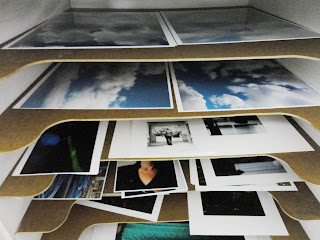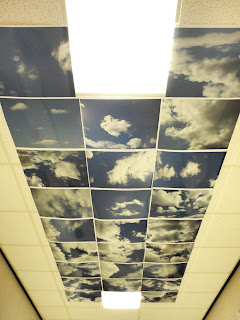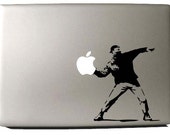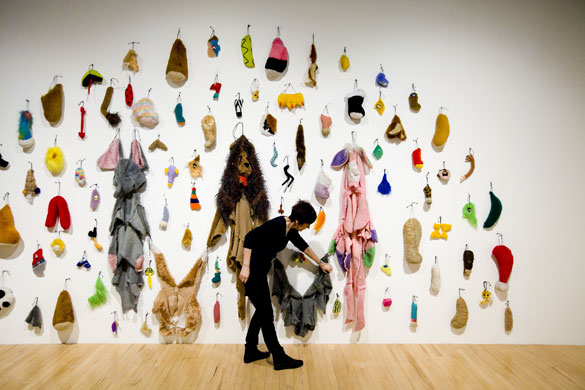Exhibit #1
Cabelas, Barbed Wire framed Animal Prints. These prints were on display in the home section on a wall, all of them were for sale. Dimensions are 14 3/4'sX17 3/4's.
The first picture I looked at was of a male caribou laying down amongst its heard. His head is raised, which makes him appear on alert in comparison to the other animals. I think whats being conveyed is the ideal setting for a hunting party. The caribou has a large rack, which makes him a valuable target. But having the picture in this context, in a hunting and fishing store makes it difficult to discern any alternative motives aside from hunting.
Describe:
The picture is actually very pretty. It has neutral colors, and is encased in a large wooden frame that has barbed wire wrapped around the outside, and several smaller caribou animals on the frame itself. The painting is monochromatic, and has two caribou laying on the ground. The larger animal is obviously the male, he has a large rack and beautiful brown and beige colorings. The other animal is a female who is sleeping towards the front plane of the piece. There are also two black and white birds lingering in the picture as well.
I think it's a very well done print. I love the coloring, and how they chose to present it in the old wooden frame with the wire. I really like the rustic, outdoors look and thinks it's a very pretty piece of art work.
A framed print of a painting, which has two caribou laying down in their herd. Surrounded by a old wooden frame, inlaid with barbed wire and more caribou figures.
It's a display in a hunting store, it's about animals, mostly big game animals that are popular among hunters. The prints are beautiful though, and they show the grace of these beasts in all their glory.
Docile, calm, peaceful, relaxed, rustic, outdoors, protection, safe keeping, serenity, family, alert, sleepy, down time, satisfied, comfortable, cautious, wild.
They have a small display which shows the name, and the dimensions of the piece, as well as the price. They are arranged nicely on the wall, makes it appear more like a museum show piece rather than an art sale.
These animals I assume are representations of what we know of caribou behavior in the wild.
The point of view is straight forward. The animals are almost centered, and lined up, the female in front of the male. However, they're both lying sideways. The male caribou has his head turned slightly towards the viewer.
Interpret:
The overall meaning I think is how caribou act in the wild, and how they act with each other within their herd. Like I mentioned earlier, the male seems to be on alert, as if he's heard a noise. This could be a representation on the caribou being hunted from the caribous perspective, how they first hear the noises of the hunters drawing closer. But that could also be a misinterpretation based on where the picture is located.
The rest of the herd isn't included in the image, just the two animals in front. But there is a indication of another animal nearby; you can see the rump, or butt of another animal from behind the male caribou.
I think the information is conveyed to reach a certain audience, in this case being hunters, or outdoors
men who shop at Cabela's and likes for their out going lifestyles to be reflected in the decor of their house. I think the context from which the artwork is displayed does have an impact on its meaning directly. I wouldn't expect to see a piece like this in a coffee shop.
Exhibit #2
Cabela's. Hayden Lobson Wildlife Prints.
The Den Mother. For sale on wall of Cabelas. Dimensions are 27 X35. Paint.
Describe:
The painting is about a family of bears, a momma and two cubs. All three of them are standing on a river bank, surrounded by walls of rocks, and fallen trees with moss growing on them. There's also a river, or a glimpse of a river flowing in front of them. I think it's a really happy picture, seeing a family of bears together, in their private environment.
My first impression is that it almost seems kind of ironic, showing a picturesque glimpse of a happy bear family in a hunting store, filled with guns and stuffed dead animals.
It's a square picture, plain wooden frame. The picture is a print from an original painting, which depicts a bear family, a momma and her two cubs. Behind them, they're surrounded by large rocks and fallen trees covered in moss. In front of them is a river, and a small water fall which the bear cub is standing next to.
It's a picture of a bear family, near a river bank in the woods. The momma bear is a brown bear, while her two cubs appear to have a darker coat of fur. I'd assume this setting is in the spring time, because that's the usual mating season for wild life.
Wild but tame, calm, serene, family, togetherness, dedication, love, playfulness, trust, curiosity, teamwork, adventure, survival, strength.
Under the paining there is a small plaque that says the title of the work,
The Den Mother by Hayden Lambson. It's also hung on the same wall as the last painting mentioned above, so it has the same museum appearance.
I would have to say its a simulation of what the artist visualizes as animals living in the wild as a family. The representation I would assume is accurate however.
The viewer is looking directly towards the bears, and the bears faces are pointing all different directions, except for one cub who looks like he's curiously looking out at the viewer, while sniffing the air.
Interpret:
The overall meaning, I'd say is the meaning of family, and survival. It's a family of wildlife, but we still all have the same basic instincts when it comes to survival. I think the representation of wildlife, again, pertains to a certain group of outdoorsy people. I would assume the artist is one of these people, and enjoys the great outdoors. That would of course influence his work a great deal, and limit his audience and buyers, which is the outdoorsy type.
Overall, for both pieces I think they're place on the wall is very effective. It's in the home goods section of the store, which allows the viewer to decorate, or imagine a piece within a certain space.



























